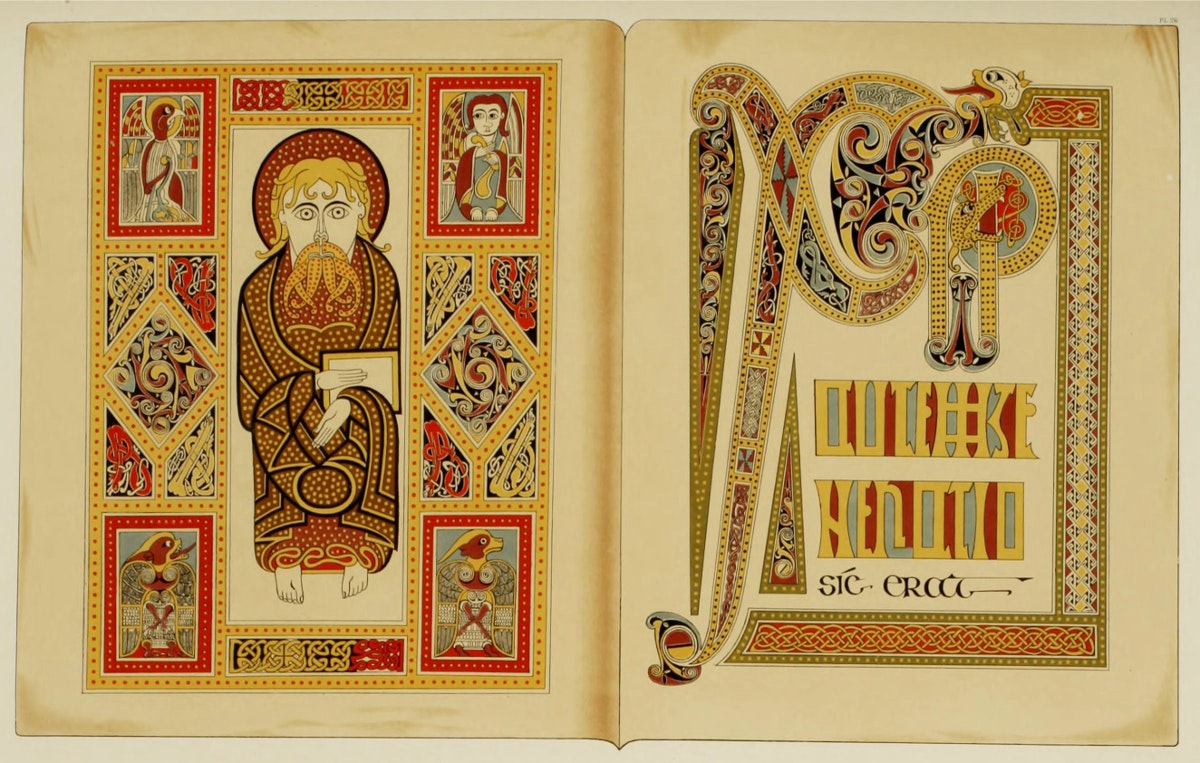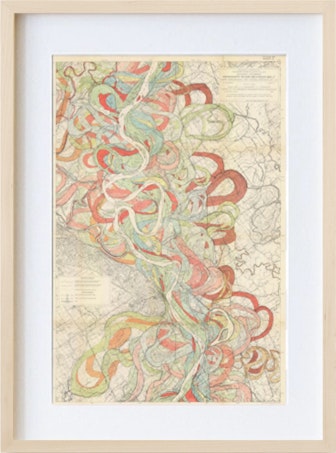
John O. Westwood’s Facsimiles of Anglo-Saxon and Irish Manuscripts (1868)
John Obadiah Westwood (1805–1893) was a bona fide polymath. An archaeologist, entomologist, editor, artist, and art historian, he was a regular contributor to the Gardner’s Chronicle, a founder of the Entomological Society of London, and the author of books about everything from sessile-eyed crustaceans to the early sculptured stones of Wales.
Westwood’s fascination with Anglo-Saxon and Hiberno-Saxon illuminated manuscripts — created in Britain and Ireland between 500 and about 1066 CE — derived in part from a distinctly Victorian national pride. He is insistent in his introduction to Fac-similes of the Miniatures & Ornaments of Anglo-Saxon & Irish Manuscripts (1868) that by publishing these chromolithographic plates, he is giving readers access to “the first chapter of a History of the Fine Arts in this kingdom, extending from the Roman occupation of Great Britain to the Norman conquest.”
But Westwood also brought to these bright, dark age illustrations an entomologist’s intensity of attention. The lithographs, made by W. R. Tymms based on Westwood’s paintings, are intended to highlight a defining characteristic of these anonymous masterpieces:
the excessive elaboration of ornamental details, often exceedingly minute, but nevertheless frequently so arranged as to afford fine broad effects in a manner which might scarcely be supposed possible, and which often, indeed, seem to be the result of accident rather than of design.
It is precisely this “peculiarity”, Westwood adds, “which renders the study of the Manuscripts and other relics of the early Anglo-Saxon and Irish schools so interesting to the Art-student.” (Whether art students would be able to spare the price of £21 — around £1300 in today's money — is doubtful, though Westwood himself was at least hoping to make an affordable volume — “a humble rival of the grand but enormously expensive work of Count Bastard on the Miniatures and Ornaments of early French MSS.”)
The lithographs themselves reproduce details, and sometimes whole pages, from manuscripts held at museums, libraries, and churches all around the British Isles. These reproductions, in the words of Incunabula on Twitter, “did much to fix the visual appearance of manuscripts like the Book of Kells in the Victorian imagination”.
While the style of the Book of Kells has by now grown relatively familiar, the lithographs of the many lesser-known manuscripts reveal the astonishing variety of styles available to these artists, over a thousand years ago. Westwood’s reproductions show us not only the artists’ ornate Celtic knots and squiggles but also their bold use of color and inventive integration of images and letters. Consider the almost American Southwestern color scheme of the seventh-century Royal Manuscript VI’s illustration of the first chapter of the Gospel of Luke, the beautiful interplay of text, ornamentation, and human figures in the ninth-century St. Gall Manuscript, or the lithe trees on either side of the crucified Jesus in the eleventh-century Arundel Psalter. It’s easy to understand how these prints could capture — and continue to capture — people’s imaginations.
You can scroll through our highlights below.
Commencement of the Gospel History of St Matthew (C I U 18) (7th or 8th century) — From the Codex Aureus of the Royal Library Stockholm
Symbols of Saints Matthew and Mark with Ornamental Page (7th century) — From the Gospels of Durrow, Trinity College Dublin
Symbols of Saints Luke and John with Ornamental Page (7th century) — From the Gospels of Durrow, Trinity College Dublin
Ornamental Pages (7th century) — From the Gospels of Durrow, Trinity College Dublin
Portion of the Genealogy of Jesus Christ (7th century) — From the Book of Kells, Trinity College Dublin
The Symbols of the Four Evangelists (7th century) — From the Book of Kells, Trinity College Dublin
Saint Matthew (7th century) — From the Book of Kells, Trinity College Dublin
The Temptation of Jesus Christ (7th century) — From the Book of Kells, Trinity College Dublin
Ornamental Page (About AD 710) — From the Gospels of Lindisfarne
Saint Matthew (About AD 710) — From the Gospels of Lindisfarne
Beginning of the Gospel of Saint Luke (7th century) — From the Royal MS I E VI (British Museum)
Saint Mark (7th century) — From the Royal MS IE VI (British Museum)
Saint John with His Symbols (Circa AD 820) — From the Gospels of Mac Regol, Bodleian Library, Oxford
David as a Warrior (8th century) — From the Commentaries on the Psalms by Casiodorus "manu Bedae" in the Cathedral Library, Durham
The Royal Psalmist (8th century) — From the Commentaries on the Psalms by Casiodorus "manu Bedae" in the Cathedral Library, Durham
The Evangelical Symbols Conjoined (8th century) — From the Gospels of Thomas (Abbot of Hohenaugia) Capitular Library, Trèves
Symbols of Saints Matthew and Mark (9th century) — From the Latin Gospels in the Imperial Library, Paris
Saint Mark and Evangelical Symbols (8th or 9th century) — From the Gospels of Saint Chad, Lichfield Cathedral
Beginning of the Gospel of Saint Matthew (8th century) — From the Gospels of Saint Petersburg (Saint Germain des Prés 108)
Ornamental Page and Glorification of Jesus Christ (9th century) — From the Latin Gospels in the Conventional Library of Saint Gall
The Crucifixion & Commencement of Penitential (9th century) — From the Library of Saint Gall Cod. No. 1895
David's Victories over Goliath & the Lion & Commencements of Psalms 1 & 102 (9th century) — From the Psalter of Saint John's College, Cambridge
Ornamental Initial Letters (Second half of 10th century) — From the Codex Vossianus (Bodleian Library Oxford, Psalt. Jun. 27)
The Word Made Flesh, Beginning of the Gospel of Saint John (End of 10th century) — From the Great Latin Gospels, Public Library, Boulogne
David with Musical Instruments (About AD 1000) — From the Great Latin Psalter, Public Library, Boulogne
Commencement of the Psalms, with the Exploits of David (About AD 1000) — From the Great Latin Psalter, Public Library, Boulogne
The Saviour of the World (End of the 10th century) — From the Latin Gospels, Trinity College, Cambridge
The Women at the Sepulchre & Saint Michael & the Dragon (End of 10th century) — From the Cottonian Psalter (Tiberius CVI), British Museum
The Crucifixion and Commencement of the 101st Psalm (11th century) — From the Arundel Psalter, No. 60, British Museum
Sep 4, 2019







